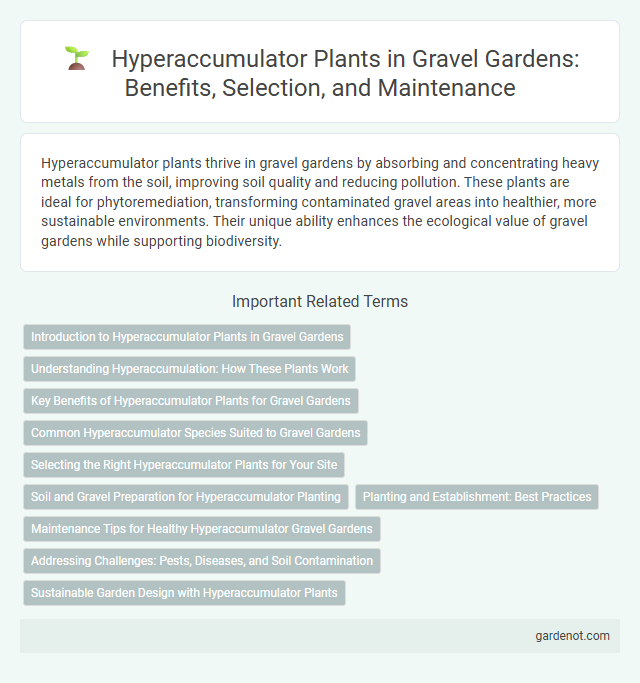Hyperaccumulator plants thrive in gravel gardens by absorbing and concentrating heavy metals from the soil, improving soil quality and reducing pollution. These plants are ideal for phytoremediation, transforming contaminated gravel areas into healthier, more sustainable environments. Their unique ability enhances the ecological value of gravel gardens while supporting biodiversity.
Introduction to Hyperaccumulator Plants in Gravel Gardens
Hyperaccumulator plants in gravel gardens excel at extracting heavy metals and pollutants from the soil, enhancing ecosystem health and preventing contamination spread. These specialized species thrive in nutrient-poor, well-drained gravel substrates by concentrating metals like nickel, cadmium, and zinc within their tissues. Incorporating hyperaccumulators into gravel garden designs promotes phytoremediation, supports biodiversity, and improves soil quality over time.
Understanding Hyperaccumulation: How These Plants Work
Hyperaccumulator plants thrive in gravel gardens by absorbing and concentrating heavy metals from the soil at levels 100 to 1,000 times higher than typical plants, effectively detoxifying contaminated environments. These plants use specialized cellular mechanisms, such as metal-binding peptides and vacuolar sequestration, to tolerate and store toxic metals without damage. Understanding hyperaccumulation reveals their potential in phytoremediation, making gravel gardens not only aesthetically pleasing but environmentally beneficial.
Key Benefits of Hyperaccumulator Plants for Gravel Gardens
Hyperaccumulator plants enhance gravel gardens by efficiently extracting heavy metals and toxins from the soil, promoting healthier plant growth and ecosystem balance. These plants improve soil quality and prevent contamination, making them ideal for urban or industrial garden settings. Their low maintenance and drought resistance also contribute to sustainable and visually appealing gravel garden designs.
Common Hyperaccumulator Species Suited to Gravel Gardens
Common hyperaccumulator species ideal for gravel gardens include Alyssum murale, Arabidopsis halleri, and Thlaspi caerulescens, known for their ability to absorb heavy metals like nickel and zinc from contaminated soil. These plants thrive in well-drained, low-nutrient environments typical of gravel gardens, making them effective for phytoremediation and sustainable landscaping. Their tolerance to harsh conditions and metal uptake capacity enhances soil detoxification while maintaining aesthetic appeal in minimalistic garden designs.
Selecting the Right Hyperaccumulator Plants for Your Site
Selecting the right hyperaccumulator plants for your gravel garden involves identifying species known for their ability to thrive in poor, rocky soils while effectively absorbing heavy metals or pollutants. Species like Alyssum murale, Thlaspi caerulescens, and Pteris vittata are renowned for their heavy metal uptake capabilities and adaptability to dry, gravelly conditions. Matching hyperaccumulator plants to site-specific soil contaminants and environmental factors optimizes phytoremediation efficiency and promotes sustainable garden health.
Soil and Gravel Preparation for Hyperaccumulator Planting
Soil and gravel preparation for hyperaccumulator planting requires selecting well-draining substrates rich in essential minerals like nickel, zinc, and cadmium to support metal uptake. Incorporating a balanced mix of sandy loam with coarse gravel enhances aeration and prevents waterlogging, creating optimal root conditions for hyperaccumulator species such as Alyssum murale and Pteris vittata. Regular soil pH monitoring and amendments with organic matter help maintain nutrient availability and maximize heavy metal absorption efficiency in gravel garden environments.
Planting and Establishment: Best Practices
Hyperaccumulator plants thrive in gravel gardens by requiring well-drained, nutrient-poor soils that mimic their natural habitats. Establishment involves selecting species such as Alyssum murale or Thlaspi caerulescens, known for their heavy metal uptake, and planting them during early spring for optimal root development. Regular monitoring of soil pH and metal concentration ensures healthy growth and maximizes phytoremediation efficiency.
Maintenance Tips for Healthy Hyperaccumulator Gravel Gardens
Hyperaccumulator plants in gravel gardens require minimal watering due to their drought tolerance, making well-drained gravel soil essential to prevent root rot. Regularly removing debris and monitoring soil pH ensures optimal nutrient absorption and heavy metal uptake. Periodic pruning promotes healthy growth and prevents overcrowding, maintaining the garden's aesthetic and functional benefits.
Addressing Challenges: Pests, Diseases, and Soil Contamination
Hyperaccumulator plants in gravel gardens effectively extract heavy metals and pollutants from contaminated soils, enhancing soil health and safety. These plants face challenges such as pests and diseases that can reduce their phytoremediation efficiency and overall growth. Implementing integrated pest management and regular monitoring of soil contaminants are essential to maintain plant vigor and optimize soil detoxification processes.
Sustainable Garden Design with Hyperaccumulator Plants
Hyperaccumulator plants play a crucial role in sustainable garden design by extracting heavy metals and toxins from the soil, improving soil health naturally. Incorporating species such as Alyssum murale and Pteris vittata in a gravel garden not only enhances phytoremediation but also supports biodiversity and reduces chemical use. Their adaptability to nutrient-poor, well-drained substrates makes them ideal for low-maintenance, eco-friendly landscaping solutions.
Hyperaccumulator plant Infographic

 gardenot.com
gardenot.com